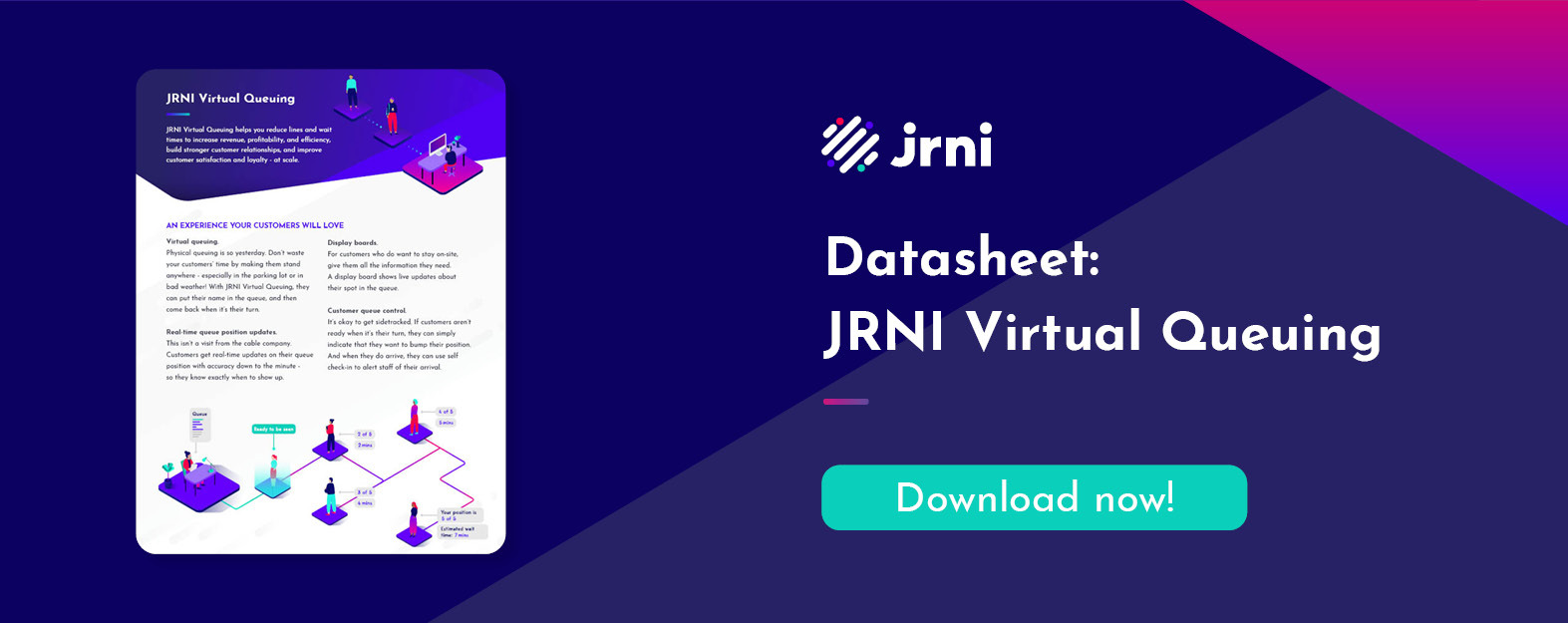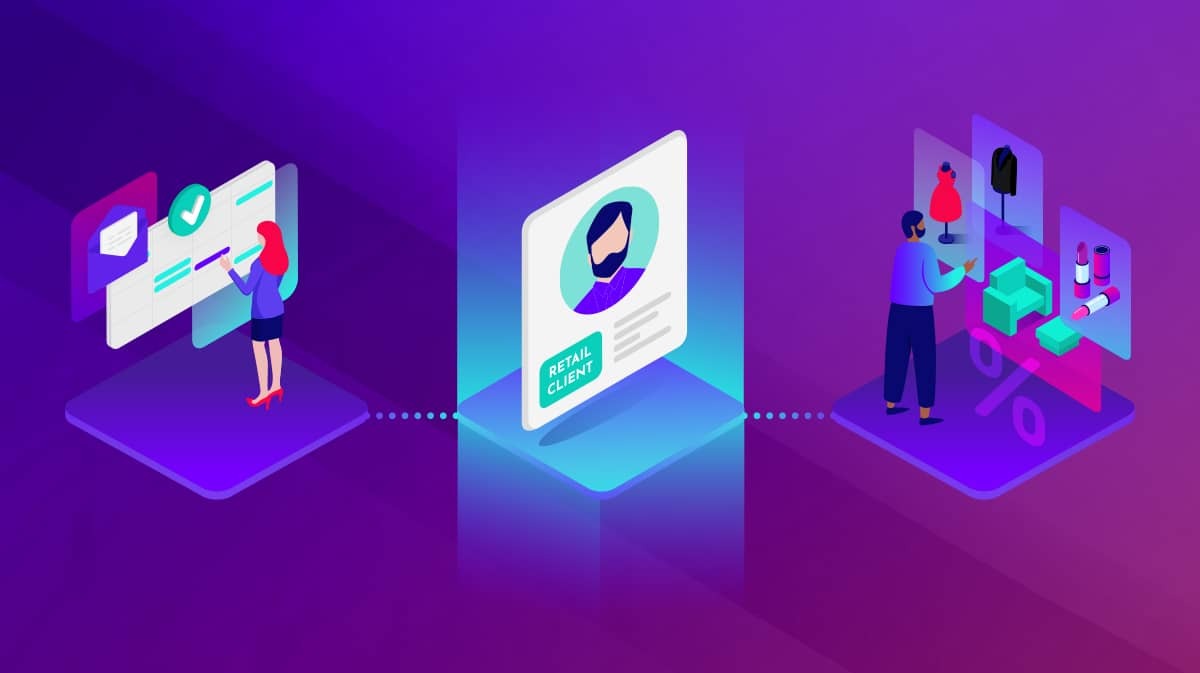COVID-19 has had a sweeping impact on businesses across the globe, and it shows no sign of slowing down. As the pandemic continues to play out, many businesses are moving their customer experiences online for the health and safety of their customers. Although this transition comes with obvious changes for both businesses and the people they serve, some parts of the customer journey remain the same.
Regardless of whether customers are interacting with a business in-person or online, waiting is often a key part of the customer experience. No matter how customers are waiting—standing in line in a bank or retail location, sitting in their cars, or multitasking at home—businesses should create a waiting experience instead of leaving customers to stew in the frustrations of boredom and wasted time. It’s time for businesses to create a digital waiting experience.
Rather than considering the necessity of transitioning to online services as a negative, businesses can view it as an opportunity. Before the pandemic, many consumers were already expressing an interest in involving technology in the shopping process. In fact, a survey conducted by Bouncepad revealed that 78 percent of consumers want retailers, restaurants, and hotels to do a better job of using technology to improve the customer experience. Businesses should take that as a green light to use the critical digital waiting experience to optimize the customer experience.
Features and benefits of digital waiting rooms
According to the New York Times, Americans spend about thirty-seven billion hours each year waiting in line. That’s a large number, but it pales in comparison to how long Americans feel like they’re spending in line. It’s not surprising, then, that research on queuing suggests people tend to overestimate how long they spend in lines by about 36 percent. Research also suggests that wait times feel shorter when people are occupied as opposed to unoccupied.
Key to a successful digital waiting room are features that distract customers from both real and perceived wait times. Businesses should look to educate and entertain customers while they wait, striving to make the wait time more productive and less frustrating.
Highlighting products and services
For example, the best digital waiting room or lobby experiences will educate waiting customers about new or additional products and services. Retailers can highlight special promotions, showcase new styles, or inform customers about curbside pickup options. Similarly, banks might highlight new video banking services or financial planning services. Showcasing services that help meet customers’ altered needs during the COVID-19 pandemic is especially valuable right now.
Offering reassurance and establishing trust and credibility
Businesses should likewise focus on preparing customers for the interaction awaiting them on the other end of their wait time and providing reassurance in what is undoubtedly an anxiety-filled time for many. While waiting for an in-store appointment, for example, customers can be shown more information about the cleaning regimen and safety precautions their local store or bank branch is utilizing for their protection. Additionally, customers can learn what documentation or identification they need to have ready for their upcoming appointment or transaction, which offers the added benefit of streamlining the upcoming customer interaction.
While highlighting health and safety measures to build customer trust, businesses can also more generally use waiting time to educate customers on their areas of expertise. A local bank branch might, for example, highlight mortgage experts or small business loan specialists to expand customer awareness.
Providing entertainment
Lastly, businesses shouldn’t neglect the opportunity to entertain customers while they wait. Interactive quizzes and games distract customers and provide a platform for additional educational opportunities. A fun financial literacy quiz can assess a customer’s existing knowledge base concerning financial services and serve as a segue for tailored product and service recommendations.
According to research from the Content Marketing Institute, 77 percent of marketers agree that interactive content can have reusable value. In other words, it encourages repeat customers and multiple exposures. So interactive content is especially important for businesses looking not only to improve customers’ current waiting experience but also to encourage repeat customer interactions.
Creating a digital waiting experience that works
A frustration-free wait experience is the overall objective for any digital waiting room. Successfully creating such an experience requires effort. Businesses looking to meet this objective can focus on three key tools: virtual queue management solutions, digital signage, and designated web pages.
Virtual queue management solutions
Virtual queue management solution systems include front-end and back-end features that provide advantages to both customers and staff alike.
Front-end features provide customers with self-service options to add or remove themselves from the queue and choose what services they need during the booking process. The system can also provide customers with a predicted wait time and alert them with SMS notifications when they are near the front of the line. Providing customers with greater control over their waiting experience and updates about wait time helps reduce frustration.
A key back-end feature of virtual queue management systems is a robust staff dashboard. This dashboard can provide staff with up-to-date line metrics and help prepare them for upcoming customer interactions by providing information on who is next in line, how long they have waited, and what they need. Queue management systems also provide valuable data that businesses can leverage for future customer experience optimization. This includes data on peak service times, top customers, and basket size.
Digital signage
Digital signage is a great way to optimize the customer waiting experience—and benefit staff as well. Whether in stores or in parking lots, digital signage can provide customers with up-to-date, rotating information on a business’s products and services and health and safety policies. In addition to the more obvious information—cleaning regimens, promotions of new products—consider the other myriad messaging opportunities with good digital signage:
- Alert customers to what they need to be prepared for when they go inside, especially in terms of face mask and social distancing policies.
- Highlight information about local store or branch managers.
- Advertise job openings.
- Provide upbeat messaging, whether it’s a “Welcome back!” or a thank-you note to staff and customers supporting your business during closures.
And don’t forget to maximize technology use with your digital signage. Many facilities currently have a maximum capacity; attaching an automatically updating data source (via Excel, for example) to your digital sign helps potential customers keep track of how many people are currently onsite.
Designated web pages
While providing educational content to waiting customers, digital signs can also direct customers—especially those waiting in their cars—to specific web pages. And by functioning as an ideal platform for interactive content, they’re a great resource for customer entertainment.
Businesses should ensure that all their designated web pages for customers waiting in line are mobile friendly. After all, more than 50 percent of Google searches are now done via mobile devices. Likewise, businesses should tailor web pages geographically. By analyzing customer data, companies can highlight the most popular products or services on regionally specific web pages to best meet customer needs.
Improving the digital waiting experience
If a business seeks to best meet customer needs, it can’t rest on its laurels and become complacent once it has established a virtual waiting experience. Instead, businesses must continue to tweak and track the system’s success by managing its operation for improved performance. For example, businesses should test features of the system and ensure that designated web pages are, in fact, mobile-friendly and that customers receive SMS notifications about their place in line at the correct time.
As mentioned, businesses should consider integrating customer surveys along with interactive quizzes and games into the waiting experience. While functioning as activities to keep customers occupied and reduce their perceived wait time, such surveys can help companies find out what’s working well and what needs some retooling.
Survey data also works well to complement the data that a queue management system provides. Consequently, both data sets help banks and retailers improve their digital waiting experience for optimal customer and staff experience, thus improving overall business success.
Ultimately, a successful digital waiting experience is a great touchpoint that enhances and streamlines the customer’s experience with your company. And now, more than ever, it’s time for your digital engagement solutions to shine.
Resources for your business
In the face of uncertainty, digital solutions are evolving to help serve the needs of your business and your customers. For more information on how JRNI’s virtual queuing solution can help assist your company during and beyond the COVID-19 pandemic, check out our queuing datasheet and consider reaching out to a JRNI representative for more guidance.




